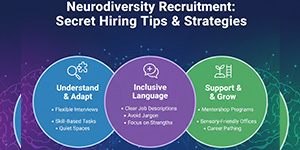The Importance of HR Analytics in Organization
HR analytics has emerged as a transformative tool for firms seeking to optimize workforce performance and link human resources with strategic goals in today's data-driven environment. With businesses facing increased competition leveraging HR data analytics to address changing work trends and the demand for operational efficiency is now required and not a luxury.
So, what is HR data analytics? It refers to the systematic collection, analysis and interpretation of human resources data to improve decision-making. Often interchanged with HR data analytics, this method gives HR departments the ability to forecast trends recognize problems and put data-driven solutions into action.
Understanding HR Analytics: Definition and Core Concepts
What is HR analytics? It is essentially the use of statistical techniques and instruments to examine data pertaining to employees. Using data science, it finds actionable insights that go beyond basic HR indicators. Unlike traditional HR practices which often rely on intuition, HR analytics promotes making decisions based on evidence.
What is the role of HR analytics in modern organizations? It facilitates:
- Talent acquisition and retention strategies
- Workforce planning and forecasting
- Diversity and inclusion initiatives
- Increased productivity and employee engagement
- Systems for managing performance
This particular type of analytics makes sure that HR is a strategic partner in the success of the company not just an administrative function.
How to Get Started with HR Analytics
For businesses that are unfamiliar with data-driven HR knowing how to get started with HR analytics can be intimidating. This is a detailed how-to for creating a strong HR analytics framework:
- Set Goals: Decide which specific HR problems, like low engagement or high attrition you want to address.
- Gather Useful Information: Compile internal information such as attendance, employee demographics performance evaluations and outside standards.
- Invest in Tools: Use platforms like Power BI Tableau or specialized HR analytics tools to streamline data processing.
- Develop a Skilled Team: Educate your HR staff on data interpretation or hire data analysts with HR experience.
- Begin Small, Scale Gradually: Begin with one focus area (for example, recruitment) and then expand once the team is comfortable.
- Ensure Data Privacy: Follow legal and ethical rules while using employee data.
Knowing how to use HR analytics effectively starts with aligning your goals with measurable outcomes. As organizations embrace digital transformation, this initial setup becomes a strong foundation for long-term value creation.
Use Cases: Real-World Applications of HR Analytics
Real-world examples are the most effective way to understand the power of HR analytics. These use cases demonstrate how organizations leverage data insights to address difficulties make informed decisions and also ultimately align HR practices with strategic business goals. The following cases illustrate how HR analytics can value add to the business strategy in practical and impactful ways also.
Example 1: Reducing Employee Turnover
A retail chain facing high attrition used HR analytics to identify patterns in resignations. The HR team improved its employee engagement activities by studying exit interviews, job satisfaction surveys, and workload distribution, resulting in a 20% decrease in turnover.
Example 2: Enhancing Recruitment Strategies
A tech firm used HR analytics to streamline its hiring process. By evaluating past hiring data they identified which sources produced the best candidates. This insight resulted in more effective job postings shorter hiring timelines and higher candidate quality also.
These examples illustrate how HR analytics can value add to the business strategy by increasing efficiency and improving talent management. Practical data guarantees that HR activities whether they are focused on improving employee morale or reducing hiring bottlenecks are in line with business goals also.
Key Benefits of HR Analytics
What are the benefits of HR analytics? The following are some indisputable benefits:
- Better Decision-Making: Data-driven insights replace guesswork with strategy.
- Improved Employee Experience: Analyzing employee feedback and behavior helps tailor HR policies.
- Improved Productivity: Efficiency is raised by identifying untapped talents and top performers.
- Cost Reduction: By anticipating HR requirements predictive analytics helps save overhead also.
- Strategic Alignment: Guarantees that HR endeavors correspond with the objectives of the company.
Additionally, what are the benefits of HR analytics in long-term business performance? Stronger revenue growth, greater employee happiness and improved flexibility during organizational changes are all reported by businesses that use analytics-driven HR processes. With the ability to anticipate talent gaps evaluate training impact and measure the ROI of HR programs analytics becomes a driver of continuous improvement.
Overall, HR data analysis transforms HR into a performance powerhouse and also provides a quantifiable return on investment.
How can hr analytics value add to the business strategy
If you’re wondering how to use HR analytics the secret is integration. The following is how to incorporate it into your business plan:
- Link KPIs with Business Goals: Map HR metrics (like turnover rate, absenteeism, engagement) to broader company objectives.
- Build Predictive Models: Using past data, project future HR requirements (such as hiring and training).
- Benchmark Against Industry: To maintain competitiveness, compare internal measures with external norms.
- Communicate Insights: To inform stakeholders use visual dashboards along with periodic reports.
Most importantly, organizations must understand how HR analytics can value add to the business strategy by providing useful insights that promote sustained progress. All decision-making levels, from team leaders to boardrooms need to be informed to ensure that the business expands alongside its workforce.
Challenges and Solutions in HR Analytics
Notwithstanding its advantages there may be challenges in putting analytics for HR into practice:
- Data Silos: For a coherent analysis integrate all HR systems.
- Insufficient Knowledge: Make training investments or work with data science teams.
- Opposition to Change: Encourage a culture that prioritizes making decisions based on facts.
By addressing these challenges, organizations can fully realize what is the role of HR analytics and make the most of its potential. Although there may be growing pains along the way the benefits include improved talent management competitive advantage and wiser choices.
Conclusion
HR analytics is reshaping the way businesses manage and engage their workforce. Knowing what analytics in human resources, knowing how to get started with HR analytics and mastering how to use HR analytics are essential steps for modern organizations.
From increasing hiring to increasing retention, the benefits are vast. Moreover, recognizing how HR analytics can value add to the business strategy guarantees that HR will continue to be a key factor in growth.
Organizations that embrace HR analytics today are not just solving current challenges they are preparing for a smarter data-driven future. Investing in the right people, tools and data culture ensures that the potential of analytics for HR is fully realized across all levels of the organization.
Read More: How to Become an HR Business Partner: Skills, Resume Tips & Career Guide





